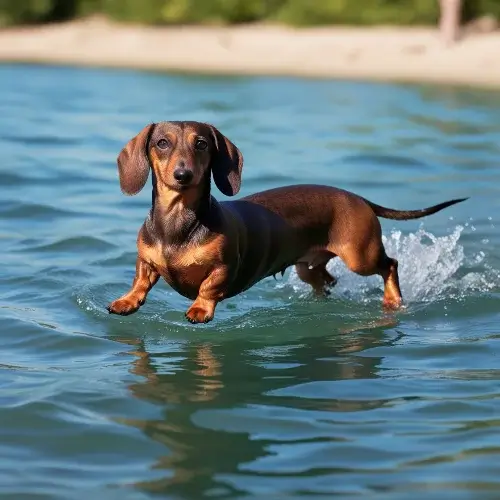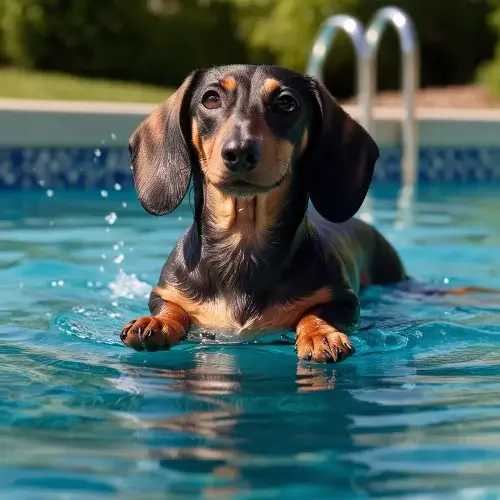Can Dachshunds Swim? Essential Safety Tips & Training Advice
When you see a Dachshund with their short legs and long bodies, the question pops up can Dachshunds swim? It’s a natural one. Dachshunds aren’t exactly built for swimming, but it doesn’t mean they can’t do it! Here’s what you need to know if you’re thinking about letting your Dachshund splash around in the water.
Table of Contents
Can Dachshunds Swim?
Dachshunds can swim, but they’re not the best at it. Their bodies are long and low to the ground, with legs that don’t give them much reach. This makes paddling through the water a real workout. They also tire more easily because their short legs have to work extra hard just to keep them afloat.
Challenges Dachshunds Face in Water
Here are some of the biggest challenges Dachshunds face in the water:
- Short Legs: They move a lot, but they don’t push much water, so Dachshunds can struggle to get anywhere.
- Long Bodies: Their long backs make it hard for them to stay balanced, especially when waves or currents are involved.
- Quick Fatigue: Swimming uses up a Dachshund’s energy quickly, so they can tire out in no time.

Even though they can swim, a Dachshund’s body shape means they might not be able to keep it up for long. So, if your Dachshund is around water, it’s best to keep an eye on them.
Do Dachshunds Like Water?
Dachshunds were bred to hunt, not swim. They were made to dig and burrow into tunnels, not dive into lakes. So, do they even like water? Not usually, but some might enjoy splashing around if you help them feel safe. Dachshunds who like water often learn to like it by following other dogs or getting used to it slowly.
For a Dachshund that’s never been in water, the best way is to introduce them to it little by little. Start with shallow areas where they can stand and feel in control. Some Dachshunds might start to enjoy wading and may eventually want to try paddling. But for others, shallow water might be as far as they want to go—and that’s fine, too.
Keeping Your Dachshund Safe Around Water
Since Dachshunds aren’t natural swimmers, you’ve got to take steps to keep them safe. A life jacket is one of the best safety tools you can have. Even if your Dachshund seems okay with water, a life jacket helps keep them afloat without as much effort. It’s also a great way to prevent accidents if they get tired.
Choosing the Right Life Jacket for Dachshunds
Here are some tips for picking a life jacket that will work well for your Dachshund:
- Snug Fit: Dachshunds have a unique body shape, so look for a life jacket that fits their chest and back without being too tight.
- Buoyancy: Check for life jackets with extra floatation around the chest. This helps keep their head above water.
- Bright Colors: Choose a bright or reflective color so you can easily spot your Dachshund in the water.
With the right life jacket, your Dachshund can have more fun in the water without getting tired as fast. It’s a must-have for any water-loving Dachshund!
Signs Your Dachshund is Tired While Swimming
Swimming takes a lot of effort for Dachshunds. Knowing when they’re getting tired can help keep them safe. Look for these signs that show they need a break.
Physical Signs of Fatigue
- Slowing Down: If they start to paddle slower, it’s a good sign they’re getting worn out.
- Heavy Panting: Swimming takes a lot of energy, so watch for fast breathing or open-mouth panting.
- Lower Body Sinking: If their back end starts to sink or they’re struggling to stay up, they need a rest.
How to Prevent Exhaustion
To keep things safe, limit how much time your Dachshund spends swimming. Let them take breaks, even if they look excited to keep going. Remember, it’s easy for Dachshunds to get worn out in the water. Set time limits and encourage them to rest often.
Training Your Dachshund to Swim Safely
If you want your Dachshund to feel comfortable in the water, training is a great idea. With the right steps, your Dachshund can learn to feel more confident while swimming. But take it slow, and keep things positive!

Step-by-Step Tips for Introducing Water
- Start in Shallow Water: Let them walk in water that’s just a few inches deep. Let them get comfortable with the feel of it.
- Gradually Go Deeper: Once they seem okay, you can encourage them to go into slightly deeper water. Always stay close by.
- Use Toys and Treats: Bring some of their favorite toys or treats to make it more fun. This can help them see water as a good place to be.
Using Positive Reinforcement for Water Training
Reward your Dachshund for each small step they take. Treats, toys, and praise help them build confidence. Each time they get more comfortable, they’re likely to feel a little braver. Keep sessions short and upbeat to help them feel good about swimming.
Conclusion
So, can Dachshunds swim? They can, but it doesn’t come naturally to them. Because of their body shape, they need extra help and a lot of supervision. A life jacket, gentle training, and watching for signs of fatigue can help make water time safe and fun for them.
With the right support, you and your Dachshund can enjoy water activities together. Just be careful and keep it light—you’ll both have a better time!
FAQs
How do I introduce my Dachshund to water?
Start by letting your Dachshund explore shallow water and use treats or toys for encouragement. Gradually increase water depth and always provide positive reinforcement to build their confidence.
Are Dachshunds more likely to get cold in water?
Yes, Dachshunds can get cold easily in water because they lack the water-resistant coat of other breeds. If swimming in cooler weather, bring a towel or blanket to warm them up afterward.
Can Dachshunds swim in pools safely?
With close supervision and a life jacket, Dachshunds can swim in pools. Ensure they can safely exit the pool, and monitor them to prevent exhaustion since pools can tire them out quickly.
What are some signs that my Dachshund is too tired to keep swimming?
If your Dachshund starts to paddle slowly, pants heavily, or has difficulty keeping their back end afloat, they may be too tired. Give them breaks to prevent overexertion and keep swim times short.







